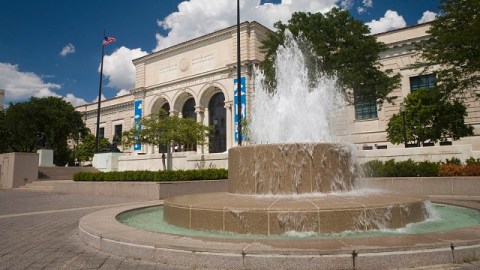Is Dying Detroit Trying to Murder its Museum?

How desperate can a city facing financial armageddon get? What’s the last resort for cities such as Detroit, wounded first by the failing American auto industry and then set bleeding like every other American city after the 2008 financial crash? Detroit emergency manager Kevyn Orr raised the possibility of selling the collection of the Detroit Institute of Arts, worth about $15 billion, to help pay off some of the city’s debt. Setting aside the complicated issue of whether a city even has the legal right to sell its museum’s collection like any other movable asset, does a city have the moral right to sell works of art? What would the long-term effect of making such a short-term decision? If dying Detroit murders its museum, will it lose its soul, and the soul of its people?
“Liquidating DIA art to pay down debt likely would be a monstrously complicated, controversial and contentious process never before tested on such a large scale and with no certain outcome,” John Gallagher and Mark Stryker explain in their story in the Detroit Free Press. “The DIA is unusual among major civic museums in that the city retains ownership of the building and collection while daily operations, including fund-raising, are overseen by a nonprofit institution.” So, even if the city could pull off this “monstrously complicated” feat, the possibility that it could be used as a precedent for other cities is remote. But, once you give lawyers an inch, there’s no telling where the machinations could end.
Consider for a moment exactly what’s at stake when you talk about the DIA’s collection—one of the most underrated collections in the United States, if not the world. From their American collection, who wouldn’t want to get their hands on John Singleton Copley‘s Watson and the Shark, George Caleb Bingham‘s The Trappers Return, James Abbott McNeill Whistler’s Nocturne in Black and Gold: The Falling Rocket, or John Sloan‘s McSorley’s Bar? Or go shopping in the European collection for Pieter Bruegel the Elder‘s The Wedding Dance, Nicolas Poussin’s Selene and Endymion or The Holy Family, or Caravaggio’s Martha and Mary Magdalene, among other treasures? But the biggest prize would be the five (that’s five!) works by Vincent Van Gogh, including The Portrait of Postman Roulin, a fascinating Self Portrait, and The Diggers. What other museum (or private buyer with greater financial power than most cash-strapped institutions) would end up with these works?
But what would be the real price of selling off the DIA essentially for parts? For anyone who thinks that Detroit cares little for the arts, they’ve never heard of The Heidelberg Project. “The Heidelberg Project is art, energy, and community,” they explain on the website. “It’s an open-air art environment in the heart of an urban community on Detroit’s East Side. Tyree Guyton, founder and artistic director, uses everyday, discarded objects to create a two block area full of color, symbolism, and intrigue. Now in its 27th year, the Heidelberg Project is recognized around the world as a demonstration of the power of creativity to transform lives.” Acting as “a forum for ideas, a seed of hope, and a bright vision for the future,” The Heidelberg Project “tak[es] a stand to save forgotten neighborhoods.” Finally, they say proudly, “It’s about healing communities through art—and it’s working!”
The Heidelberg Project claims as their mission “to inspire people to appreciate and use artistic expression to enrich their lives and to improve the social and economic health of their greater community.” As I constantly harp on in this forum, the arts play an essential role in enhancing the mathematical and cultural education of young people. Selling off the DIA would be a cruel extension of the near eradication of arts programs in schools for inner-city poor, the children who need a source of civic pride and inspiration such as the DIA the most. Imagine a child feeling like an outcast, yearning for a way to express herself, and discovering a work by Van Gogh, the ultimate outsider, on the wall of a museum in her own city. How could you take that away? Are you willing to pay that price.
Still not convinced that Detroit cares about the arts? After a fire (possibly an arson) destroyed an outdoor art exhibit created by The Heidelberg Project, volunteers from the community gathered to clean up the site and to help rebuild the installation. “That’s what the Heidelberg Project has done for the city of Detroit,” Heidelberg Project founder Tyree Guyton said as he pitched in. “It’s brought people together.” Perhaps this attempt to sell off the DIA’s collection will also bring people together. There will be those who say that paying off the debt outweighs all other considerations, but the people of Detroit want to rise above and set higher priorities for themselves and their city. Detroit may be dying in some ways, but selling off the DIA may kill the one part showing the most life.
[Image: Exterior of the Detroit Institute of Arts.]
[Many thanks to the Detroit Institute of Arts for the image above.]





